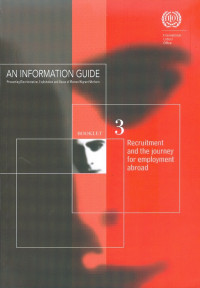
Text
Booklet 3 recruitment and the journey for employment abroad
Women migrant workers, whether documented or undocumented, are much more vulnerable to discrimination, exploitation and abuse – relative not only to male migrants but also to native-born women. Women and girls are also more atrisk than men and boys to trafficking. Gender-based discrimination intersects with discrimination based on other forms of “otherness” – such as nonnational/foreigner status,race, ethnicity,religion, economic status – placing women. in situations of double, triple or even fourfold discrimination, disadvantage, marginalization and/or vulnerability. Although the focus is on women migrant workers, many of the concerns and issues raised, analysis and guidelines provided cut across gender and, sometimes, age. Therefore, this Information Guide could be relevant for all individual migrants, women and men, so that they can better understand the risks involved in labour migration, know their rights and are better able to protect themselves. The Guide also shows why among children, girls are often more vulnerable than boys to exploitation and abuse. However, the greater vulnerability of children to exploitation and abuse and the particular physical, psychological and psychosocial harm suffered by trafficked children require that they be dealt with separately. This Guide does not deal with children-specific solutions, which should also be specific for girls and for boys. Distinguishes the different modes ofrecruitment and emphasizes that fraudulent and exploitative practices are very common in the recruitment stage. It defines illegalrecruitment and draws attention to the various dangers and risks women can face in the recruitment process. Trafficking is one form of illegalrecruitment. It describes what governments, the social actors and migrants themselves can do to prevent these malpractices.
Availability
| KP X.000131 | KP X.LIM r | My Library | Available |
Detail Information
- Series Title
-
An information guide preventing discrimination, exploitation and abuse of women migrant workers
- Call Number
-
KP X LIM r
- Publisher
- Jenewa : International Labour Organization (ILO)., 2006
- Collation
-
70p. ; 29,5 cm.
- Language
-
Indonesia
- ISBN/ISSN
-
9221137635
- Classification
-
KP X
- Content Type
-
-
- Media Type
-
-
- Carrier Type
-
-
- Edition
-
-
- Subject(s)
- Specific Detail Info
-
-
- Statement of Responsibility
-
-
Other version/related
No other version available
File Attachment
Comments
You must be logged in to post a comment
 Computer Science, Information & General Works
Computer Science, Information & General Works  Philosophy & Psychology
Philosophy & Psychology  Religion
Religion  Social Sciences
Social Sciences  Language
Language  Pure Science
Pure Science  Applied Sciences
Applied Sciences  Art & Recreation
Art & Recreation  Literature
Literature  History & Geography
History & Geography